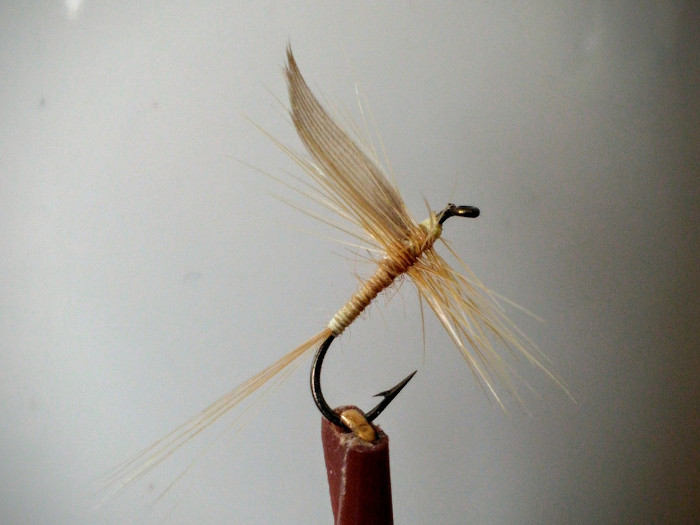We Hold These Truths To Be Self Evident
The first writing about Fly fishing has traditionally been attributed to Dame Juliana Berners I and her 1496 Treatyse of Fysshynge wyth an Angle. A recently found and earlier 1452 Austrian text, the Haslinger Breviary includes descriptions of "several score flies" so the Berners story will likely be revised in years to come. It wasn't until a good three centuries later until the first English language text mentioning dry flies first appeared. From The 1851 Vade-Mechum of Fly Fishing by George Pullman:
"Let a dry fly be substituted for the wet one, the line switched through the air a few times to throw off its superabundant moisture, a judicious cast made just above the rising fish, and the fly allowed to float towards and over them, and the chances are ten to one that it will be siezed as readily as a living insect."
Pulman wields the phrase "dry fly" as if the reader knows what it means, so we don't know how far back the practice really goes. In a chapter on Making Flies Pulman describes several dozen paterns beginning with the Early Red and the Iron Blue Dun as flies number one and two in his list. Dame Juliana mentions a "Dun Fly" too, in her 1496 text.
Perhaps 40 years or so after Pulman George Selwyn Marryat gave us the Little Marryat and Frederick Halford--a contemporary and collaborator of Marryat's--began to write a series of influentianl books about dry fly fishing. Halford is not known as a fly designer but he was a stalwart practitioner and a strong-willed moralist who did his best to re-define fly fishing as dry fly fishing only, upstream only and only to actively rising fish. And nothing else.
Halford may have had similarly minded allies and compatriots in his day but it was only Halford who wrote a long and influential series of "Dry Fly Fishing Upstream Only" books. Halford's authoritarian moralism was soon to be met with narrow eyes, ironic frowns, wrinkled eyebrows and lowered chins a few years later; across and on the other side of the Atlantic Ocean.

Fly fishing in the States took a rebelllious turn I soon after Marryat and Halford made their marks in England, with the Stateside works of Pennsylvanian Theodore Gordon and his New York contemporary George Michel Lucien La Branche. Gordon didn't write books but he did write for the magazines of his day, including the Fishing Gazette and Forest and Stream. Gordon left us with a rich library of letters too I .
Gordon's relationship with Halford is interesting. They were not only contemporaries they knew each other. Halford even sent flies to Gordon at one point. In his letters Gordon mentions Halford frequently, sometimes admiringly and other times the way a person might refer to a beloved but annoying cousin. In one of his longer pieces, written March 17, 1906, Gordon declares:
"Fishing big streams in early Spring when the water is high, it is absolutely essential to fish down for good results."
This is a respectful but adamant rebuke aimed directly at Frederick Halford, who demanded fishing upstream only. In another context Gordon wrote:
English Dry Fly Anglers now often have a contempt for the wet fly, and seem to imagine that the only way to fish wet is with several flies cast Downstream and dragging. This is absurd, as one constantly sees men casting upstream to rising fish. The only difference in method is that the fly is wet, not dry.
Contempt and absurd? Those are strong words. Gordon's first love was dry fly fishing but Gordon loved and practiced wet fly fishing too. Gordon was particularly proud of his "extraordinarily alive" Bumble Puppy streamer fly, which was surprisingly reminiscent of an early English streamer--the Alexandra--which Halford found so repulsive he could hardly contain himself when reluctantly uttering its name. Among other things Halford referred to the Alexandra as a "dreadful scourge." Gordon knew where he stood on this issue.
Gordon was a fun guy who gave us a lot more than rebellion against Frederick Halford. Gordon is often cited as the "Father of North American Dry Fly Fising." Gordon gave us the much loved Quill Gordon, which is often seen as the progenitor of what we now refer to as the Classic Catskill Dry fly. Gordon had a girl friend he liked to fish with. A century later we still do not know her name but there is at least one photograph of those two fishing together. Theodore Gordon was a seriously cool guy.
The best chum I ever had in fishing was a girl, and she tramped just as hard and fished quite as patiently as any man I ever knew. I
By the title alone La Branche's book "The Dry Fly and Fast Water" can be seen as a declaration of independence. In the quote below, from the Where and When to Fish section of the Dry Fly and Fast Water, Labranche describes "fishing the water" in order to tempt a hiding and not-currently-feeding fish.
One of the favourite feeding positions of a large trout is under this foam, and the fly, placed carefully again and again, often tempts him to move into his feeding position when, at the beginning of the casting, he lay outside of it. I
La Branche describes New England trout streams with the observant eyes of a naturalist, revealing a rich and wonderful watery ecosystem far more complex than Halford's perhaps 36" inches in diameter tunnel-vision focus on the "Cocked Mayfly."